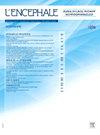Treatment strategies for clozapine-induced sialorrhea in France: A systematic review
IF 1
4区 医学
Q4 NEUROSCIENCES
Encephale-Revue De Psychiatrie Clinique Biologique et Therapeutique
Pub Date : 2025-05-05
DOI:10.1016/j.encep.2025.02.004
引用次数: 0
Abstract
Background
Clozapine-induced hypersialorrhoea (or hypersalivation) is a common side effect, and at present there is no therapeutic strategy with a validated indication to treat it. The corrective strategies proposed in the scientific literature have varying degrees of validity. As a result, it is important to regularly update the available data and to make proposals that are in line with the specialties available in each country.
Material and methods
A systematic review of the literature respecting PRISMA (Preferred Reporting Items for Systematic reviews and Meta-Analyses) statements was carried out using the PubMed, Embase and Cochrane databases with the keywords “Clozapine”, “induced”, “hypersalivation” or “sialorrhea”. Only articles dealing with substances marketed in France and written in French or English were selected.
Results
64 articles were included in this review. The various strategies identified corresponded mainly to treatments with regulatory actions on the cholinergic, noradrenergic and dopaminergic neurotransmission systems. This selection of drug strategies available in France for clozapine-induced hypersalivation identified 17 substances.
Discussion and conclusion
The level of evidence concerning treatments for clozapine-induced hypersialorrhoea remains limited. As a first option, and if clinically feasible (benefit-risk ratio), a cautious, gradual reduction in dosage is preferred. If this fails, local anticholinergic treatment may be initiated and evaluated following pharmaco-practical recommendations based on the drugs available in France and their level of evidence.
法国氯氮平诱导的唾液病的治疗策略:一项系统综述。
背景:氯氮平引起的多唾液(或多唾液)是一种常见的副作用,目前没有治疗策略和有效的适应症来治疗它。科学文献中提出的纠正策略有不同程度的有效性。因此,必须定期更新现有数据,并提出符合每个国家现有专业的建议。材料和方法:使用PubMed、Embase和Cochrane数据库,以“氯氮平”、“诱导”、“唾液分泌过多”或“唾液分泌过多”为关键词,对有关PRISMA(系统评价和荟萃分析首选报告项目)声明的文献进行系统综述。只有在法国销售并以法语或英语撰写的文章才被选中。结果:本综述共纳入64篇文章。所确定的各种策略主要对应于对胆碱能、去甲肾上腺素能和多巴胺能神经传递系统的调节作用的治疗。法国对氯氮平引起的唾液过多的药物策略进行了选择,确定了17种物质。讨论和结论:关于氯氮平引起的多涎症治疗的证据水平仍然有限。作为第一种选择,如果临床可行(获益-风险比),最好谨慎、逐渐减少剂量。如果失败,可根据法国现有药物及其证据水平,启动局部抗胆碱能治疗并根据药学实用建议进行评估。
本文章由计算机程序翻译,如有差异,请以英文原文为准。
求助全文
约1分钟内获得全文
求助全文
来源期刊
CiteScore
4.60
自引率
7.40%
发文量
162
审稿时长
6-12 weeks
期刊介绍:
Une revue française de renommée internationale.
- Un comite de rédaction représentant tous les aspects de la prise en charge psychiatrique du patient.
- Une sélection rigoureuse d''articles faisant l''objet de plusieurs expertises.
- Des travaux d''auteurs et de chercheurs de renommée internationale.
- Des indexations dans les grandes bases de données (Current Contents, Excerpta Medica, etc.).
- Un facteur d''impact qui témoigne de la grande notoriété de la revue.
La tribune des publications originales de haut niveau.
- Une très grande diversité des sujets traités, rigoureusement sélectionnés à travers des sommaires dynamiques :
- des éditoriaux de médecins référents,
- une revue de presse sur les actualités internationales,
- des articles originaux pour approfondir vos connaissances,
- des mises au point et des cas cliniques pour engager votre réflexion sur les indications et choix possibles au travers de mises en situation clinique,
- des dossiers thématiques pour faire le tour d''une question.
- L''actualité de l''AFPB : L''Encéphale publie régulièrement des comptes rendus de l''Association française de psychiatrie clinique.

 求助内容:
求助内容: 应助结果提醒方式:
应助结果提醒方式:


